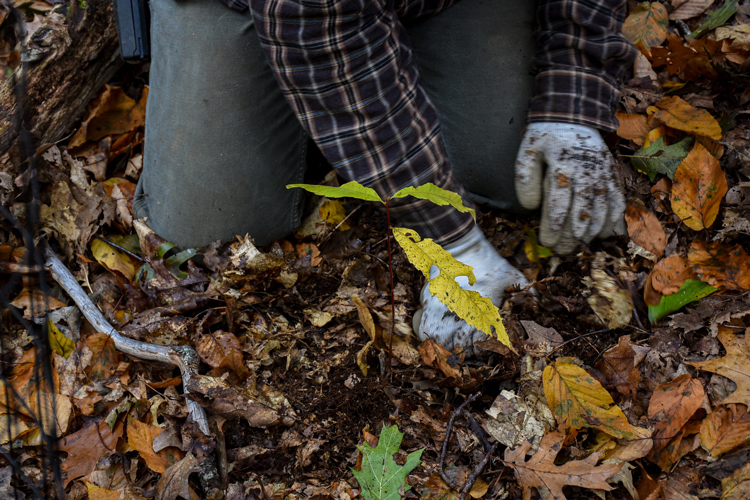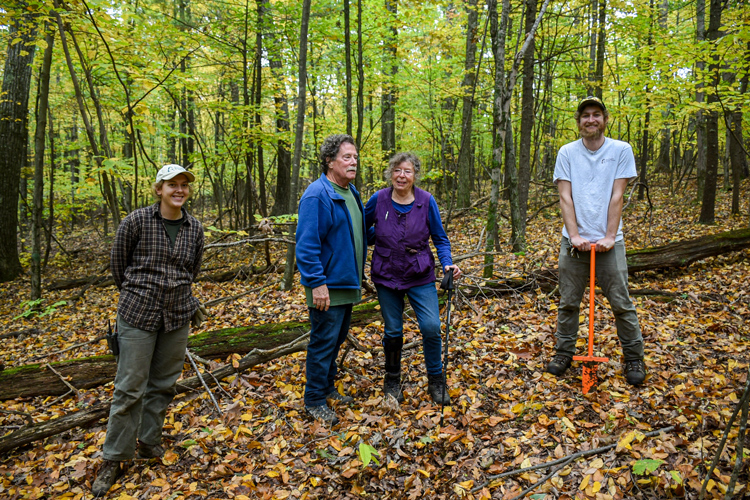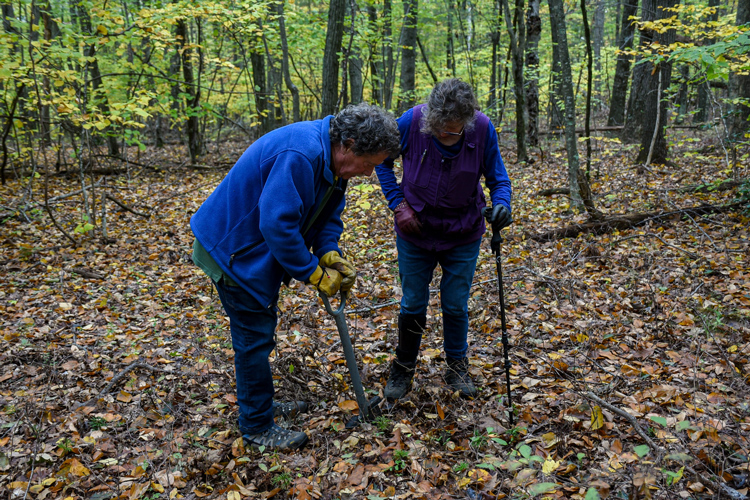By Liz Nye, New England Botanic Garden Staff
November 2023
On a cool morning in October, a small group of Garden staff and two volunteers, Lois Breault-Melican and her husband Denis Melican of Spencer, MA, set out up a short, steep trail on the north side of the Garden’s property. Led by land steward, Robert Graham, the group carried shovels, wire cages, and 20 blight-resistant American chestnut trees ready to go into the ground.
husband Denis Melican of Spencer, MA, set out up a short, steep trail on the north side of the Garden’s property. Led by land steward, Robert Graham, the group carried shovels, wire cages, and 20 blight-resistant American chestnut trees ready to go into the ground.
It was bound to be an exciting day for everyone, but especially the Melicans. They grew the young trees from seeds, something they do every year as growers with the American Chestnut Cooperators’ Foundation (ACCF). This Virginia-based nonprofit aims to restore to eastern hardwood forests a blight-resistant American chestnut tree bred for resistance the old-fashioned way — traditional backcrossing. At about two years old, the seedlings look scrawny, but they come from tough stuff.
Back in the early twentieth century, Chestnut blight (Cryphonectria parasitica), a pathogenic fungus introduced through the nursery trade, destroyed more than 3.5 billion American chestnut trees from Georgia to Maine. But it didn’t destroy them all. In the 1970s, ACCF discovered a surviving population of trees in Virginia, and the Melicans’ seedlings trace their parentage to this population. This means the Garden’s new American chestnut trees are not hybrid chestnut trees or transgenic trees genetically modified for blight resistance, but trees whose DNA is 100 percent Castanea dentata. In the still-unfolding story of American chestnut restoration, this makes them special.
“We’re excited to partner with ACCF to plant these 100 percent American chestnut trees,” Robert says. “At the Garden we have an opportunity for these trees to establish in a place that’s perfectly suited for them.” The planting site is part of an area known as the Kim property, a 26-acre parcel that features ideal chestnut habitat — sloping, rocky hillsides and a mature, mixed oak forest complete with an understory of witch hazel and mountain laurel. A heavy presence of blighted American chestnut trees offers further proof that the site can provide what this species needs. “It’s a natural chestnut hotspot,” says Denis, as he and Lois start planting.
Chestnut blight remains an active presence on the landscape. For non-resistant trees, blight is so destructive because it girdles them with cankers that cause their upper branches and trunks to die. Their roots survive, and from them, new growth tries to make another go of it. Called stump sprouts, blighted chestnuts like those on the Kim Property tend to resemble understory shrubs. Ultimately, they die back before reaching flowering age, let alone the towering sizes they historically attained. ACCF trees are different. “They are resistant to blight, but not immune,” Robert explains. “They may develop cankers and over time they could even lose limbs to the blight, but their resistance will protect them from succumbing to it.” Ideally, the seedlings will live to pass their resistance on to another generation of trees.

The Garden’s Georgia Albanese, volunteers Denis Melican and Lois Breault-Melican, and the Garden’s Robert Graham
It’s hard for people alive today to grasp the full impact of the American chestnut’s loss nearly a century ago. Trees whose presence was felt for thousands of years were gone within a single human lifespan. Though not quite as abundant and widespread in their range as once believed, American chestnut trees played an outsized role in eastern forest ecosystems and in the cultures of both indigenous people and European settlers. “They were the token tree for so many uses, and you can’t say that about many other trees,” says Robert. Chestnuts provided medicines and dyes, firewood and fence rail. Because of their immense size — roughly 100 feet tall and five to eight feet wide — they served as witness trees on land surveys. Their rot-resistant wood fueled an economy of lumber for homes and furniture, and their massive annual mast of nuts provided high-protein forage for wildlife, livestock, and people.
Over the last 20 years, the Melicans have contributed to chestnut restoration efforts in a variety of ways. They helped plant one of the first chestnut research orchards in Massachusetts at Moore State Park in 2003. In the roughly 15 years that followed, both served as board members of the Massachusetts/Rhode Island chapter of The American Chestnut Foundation (TACF), and Lois served as chapter president for many of those years. TACF, working with SUNY College of Environmental Science and Forestry, has been a leader in American chestnut restoration for decades. But when TACF started moving from backcross breeding to genetically modifying trees for blight resistance, the Melicans decided to part ways.
The topic of genetically modified trees remains divisive in the conservation community. TACF’s transgenic American chestnut, a tree known as Darling 58, possesses enhanced blight tolerance thanks to the addition of one gene inserted from a species of wheat. While Darling 58 is currently under consideration by the federal government for deregulation, some, like the Melicans, feel deeply uncomfortable with the prospect of this tree being planted in natural settings as part of chestnut restoration efforts. They prefer ACCF’s approach — decades of growing, culling, and breeding among only the offspring of the mature, blight-resistant trees discovered in Virginia. Over the last few years, the Melicans have planted ACCF trees in partnership with schools and parks across Massachusetts. This planting at the Garden is one of the first and largest naturalistic plantings they’ve been a part of.
Robert hopes the 20 trees planted this fall are just the beginning. At the next opportunity he plans to plant more ACCF trees. The project, which is the outcome of decades of research and breeding, is a long-term effort, and just one of the ways the Garden is looking to the future through conservation and land stewardship initiatives. As part of the Garden’s partnership with ACCF, staff will monitor the young trees and report annually on their progress. On sunny sites, American chestnut trees are known to grow fast, but here under an established canopy, they’ll grow more slowly. It will be seven to eight years before they flower. And before that day arrives, the Garden plans to extend its trail system further into the Kim property. At present, the trees aren’t visible from the trail, but in future, the Garden would like visitors to be able to immerse themselves in the growing populations of chestnuts and come to appreciate their story and all they can offer both ecologically and culturally. “This is the ultimate goal,” says Lois, “Planting at a place like this where people can learn about these trees.”
Out on the Kim property, the American chestnut tree seedlings were planted, caged for protection from wildlife, and tagged electronically for easy finding later. The job done, the group headed out of the woods, but not before Lois and Denis could offer a few parting words to the seedlings.
“Good luck, kids,” they say.
References & Additional Resources
- Baxter, B. N. (2009). An oral history of the American Chestnut in southern Appalachia (thesis). https://scholar.utc.edu/cgi/viewcontent.cgi?article=1333&context=theses.
- Darling 58. The American Chestnut Foundation. (2023, November 14). https://tacf.org/darling-58/
- Davis, D. E. (2021). The American Chestnut: An environmental history. The University of Georgia Press.
- Faison, E., & Foster, D. (2014, October 15). Did American Chestnut Really Dominate the Eastern Forest? Arnoldia. https://arboretum.harvard.edu/stories/did-american-chestnut-really-dominate-the-eastern-forest/#:~:text=Just%20as%20the%20bison%20was,an%20introduced%20Asian%20chestnut%20blight
- Kapoor, M. L. (2023, September 13). The American chestnut tree is coming back. Who is it for? Grist. https://grist.org/indigenous/transgenic-american-chestnut-indigenous-rights/.
- #plantofthemonth: American Chestnut. McClung Museum of Natural History & Culture, University of Tennessee, Knoxville. (2021, October 28). https://mcclungmuseum.utk.edu/2021/10/26/plantofthemonth-american-chestnut/#:~:text=Especially%20among%20the%20Cherokees%2C%20chestnuts,remedy%20typhoid%20and%20stomach%20pains.
- Regulatory status. ESF. (n.d.). https://www.esf.edu/chestnut/regulatory.php#:~:text=At%20this%20time%2C%20Darling%2058,before%20they%20are%20planted%20widely
- Smolker, R., & Petermann, A. (2019, June 12). GE American chestnut — restoration of a beloved species or trojan horse for tree biotechnology? Earth Island Journal. https://www.earthisland.org/journal/index.php/articles/entry/genetically-engineered-american-chestnut-restoration-species-tree-biotechnology/.
Liz Nye is the Public Relations Manager at New England Botanic Garden. She holds a master’s degree in science writing from Johns Hopkins University and enjoys learning about and writing about all things plants.

